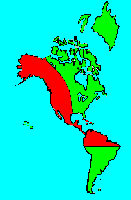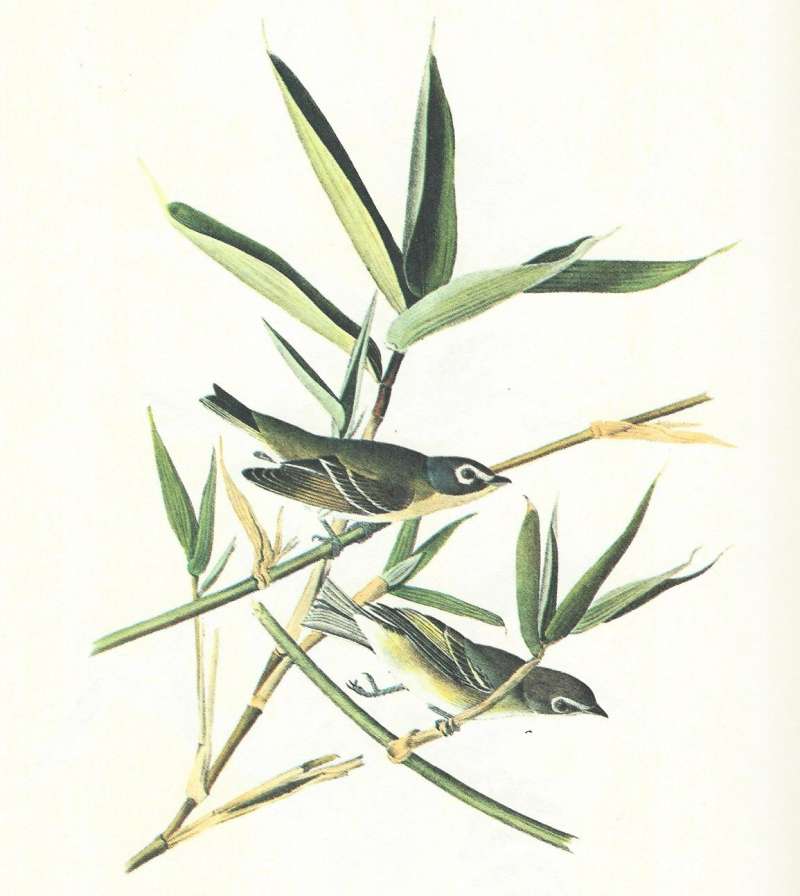SPECIES INFO
Blue-headed, or Solitary, Vireo (Vireo solitarius) breeds from Alberta to Ontario to Quebec and south into the United States to the northern portions of Minnesota and Michigan. The Blue-headed Vireo migrates as far south as Nicaragua. The dark color, gray head, and white wing bars help identify this white-eyed Vireo.
Christmas bird counts show concentrations of this species along the Gulf Coast, throughout Florida, and north along the east coast to the Carolinas.
There is a southern subspecies, V. solitarius alticola, that breeds in the southeastern United States.Vireos (Vireonidae Family) are a New World group of highly evolved Perching Birds. Although the lines of differentiation between this family and the closely related ones such as the Wood Warblers are not clear, many researchers place 42 species in this family. The following 12 species are known to occur in the United States (an * indicates the species is pictured):
Vireo antiloquus* - Black Whiskered Vireo - Caribbean
Vireo atricapilla - Black Capped - Texas & Mexico
Vireo bellii* - Bell's Vireo - Central & West United States
Vireo flavifrons* - Yellow Throated - North America
Vireo flavoviridis* - Yellow-Green - Mexico
Vireo gilvus* - Warbling - North America
Vireo griseus - White Eyed - Central and east United States
Vireo huttoni - Huttons Vireo - Pacific States
Vireo olivaceus* - Red Eyed Vireo - North America
Vireo philadelphius - Philadelphia Vireo - North America
Vireo solitarius* - Blue Headed - North America
Vireo vicinior - Gray Vireo - Southwest United States and Mexico
The typical Corvoidae (Corvoidea - Part II) is a large group of crow like birds found almost worldwide. Crows, ravens, magpies, jays, butcherbirds, bird of paradise birds, vireos, and relatives are found here.
In most modern bird taxonomies, the perching birds (Passeriformes) is treated as a single order. This large order has about 5739 different species. A common characteristic of this order is three forward toes and one reverse pointing toe. Most of species are also characterized by a tendon locking mechanism that permits their feet to lock onto branches when they relax. Recently, Monroe and Sibley in 1993 have divided this large order into six main divisions. To help our users navigate this gigantic number of species, we have arbitrarily placed these 6 different divisions at the order level.
This division can be referred to as:
Order Passeriformes (5739 species)
Suborder Passeri (4580 species)
Parvorder Corvida (1103 species)
Aves contains about 8,650 different species of living birds known to science. Each year about one new species is discovered in some remote rain forest or remote island. In addition, scientists have been raising many subspecies to full species status which may raise the species count to 10,000. Birdlife recognizes 10,027 species as of 2011.
However, each year about one species goes extinct. The rate of extinction is increasing, and the rate of new discovery is decreasing, so that the number of bird species will soon begin to decline rapidly. Although different taxonomists would organize the birds differently, there are approximately twenty-seven orders of birds. These orders are broken down into about one hundred and fifty-five different families.
Recent research of the genetic structure of some of the shore birds and owls would indicate that the present organization of orders and families should have some modification.
The birds are a worldwide group of animals that are characterized by having the front limbs modified into wings that are used for flying. Perhaps the most unique feature of the birds is the feathers. These feathers are made up of a central support called a quill and a series of small filaments that are hooked together as barbs.
For many years it was believed that Archaeopteryx discovered in Bavaria was the oldest bird from about 150 million years ago. However, in l986, Sankar Chattterjee, a Texas paleontologist, reportedly discovered a bird in the genus Protoavis that lived about 225 million years ago.
When this project was begun in 1978, we used Austin & Singer for bird taxonomy. Since then, we have adopted many changes, but have kept some older concepts that are still found widely in the literature. Recently, we have used Clements and Howard & Moore. Very recently, we have used Monroe and Sibley for the higher taxonomy of the perching birds.
Backboned Animals (Phylum Chordata) are the most advanced group of animals on earth. These animals are characterized by having a spinal cord or backbone. Most members have a clearly defined brain that controls the organism through a spinal cord. Fish, amphibians, reptiles, birds, and mammals are in this phylum.
Currently, some taxonomists believe that the fish should be divided into two groups (sharks and regular fishes) and that there are some other primitive groups in the phylum such as hagfish or lampreys.
Animal Kingdom contains numerous organisms that feed on other animals or plants. Included in the animal kingdom are the lower marine invertebrates such as sponges and corals, the jointed legged animals such as insects and spiders, and the backboned animals such as fish, amphibians, reptiles, birds, and mammals.





